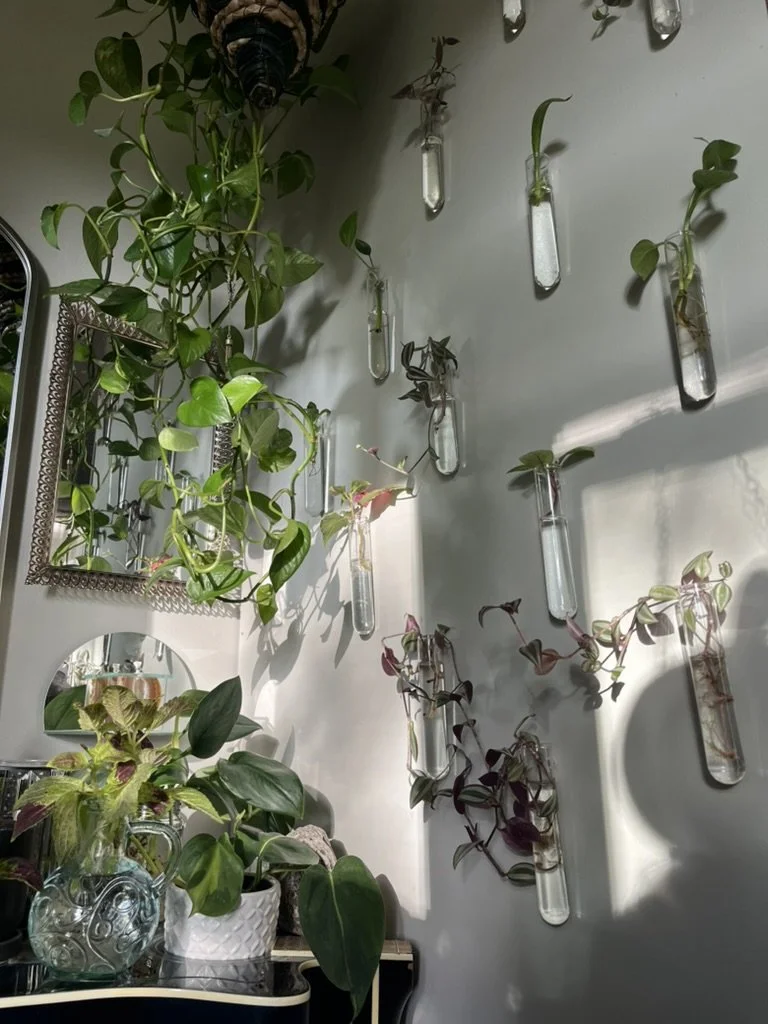The Pros and Cons of Creating a DIY Propagation Wall for Your Home Office
If you’ve been scrolling through Pinterest or Instagram lately, you’ve probably seen the stunning propagation walls popping up in homes everywhere. A propagation wall—a display of plants grown from cuttings, often in beautiful glass vials or containers—is a chic, green way to bring nature into your home office. But before you grab those scissors and head for your favorite plants, let’s break down the pros and cons of creating a DIY propagation wall for your workspace.
The Pros of a DIY Propagation Wall
1. Boosts Your Mood and Creativity Plants are proven to boost your mood and reduce stress, and having a propagation wall in your workspace brings that calming greenery front and center. The act of nurturing new life from cuttings can also be meditative, helping to inspire creativity during those long workdays.
2. Inexpensive Way to Decorate One of the best things about a DIY propagation wall is how budget-friendly it can be. Instead of purchasing new plants, you can grow them from cuttings you already have! All you need are a few cuttings from your existing houseplants (or those of a kind friend), water, and containers. Mason jars, glass vials, or even upcycled bottles can be used for a sleek, budget-friendly decor solution.
3. Easy to Maintain Propagation walls don’t require much fuss. As long as you remember to change the water every few days and keep the cuttings in indirect sunlight, your little plant babies will be happy. Plus, because there’s no soil involved, you won’t have to deal with messy pots or overwatering concerns. Simple and stress-free!
4. Space-Saving Greenery For those working with small office spaces, a propagation wall is the perfect way to introduce plants without taking up valuable desk or floor space. By going vertical, you can enjoy all the benefits of greenery without cluttering your work area. It’s also a great way to fill an otherwise blank wall, turning it into a focal point.
The Cons of a DIY Propagation Wall
1. Frequent Water Changes Can Be Tedious
While propagation walls are low-maintenance in some ways, one of the most overlooked downsides is the need for frequent water changes. To keep your cuttings healthy and prevent rot, you'll need to change the water every few days. This can quickly become an annoying chore, especially if you have multiple cuttings to manage. If you’re someone who prefers a hands-off approach to plant care, this frequent upkeep might feel more like a hassle than a hobby.
2. Fragile and Easy to Knock Over
If you’re using glass vials for your propagation wall, there’s always the risk of accidentally knocking them off and breaking them. Whether it’s bumping the wall while moving around your office or simply brushing past them, those delicate containers can easily fall and shatter, leaving you with a mess of glass and water to clean up. If your workspace is in a high-traffic area or you tend to be a bit clumsy, this added fragility could turn into a real headache.
3. Needs the Right Lighting Propagation walls need good, indirect light to succeed. If your home office doesn’t have access to natural light or you’re stuck in a dim corner, the growth of your cuttings may be stunted. You can work around this by investing in grow lights, but that adds another layer of complexity and cost to the project.
4. Limited Variety While a propagation wall looks gorgeous, not all plants can be propagated in water. You’ll be limited to species like pothos, philodendrons, spider plants, or certain types of succulents. If your plant preferences lean toward other varieties, you might find the selection limiting.
5. Requires Patience Plant propagation is a slow process. It can take weeks—or even months—before you see substantial root growth, and even longer before those cuttings are ready to be potted. If you’re someone who craves instant gratification, waiting for your cuttings to grow might feel like watching paint dry.
6. Risk of Rot One of the main challenges with a propagation wall is that the cuttings are more susceptible to rot, especially if the water isn’t changed regularly. If you’re not consistent about maintenance, you might notice the water becoming murky and the cuttings failing to thrive.
Conclusion: Is a DIY Propagation Wall Right for You?
A DIY propagation wall is a trendy, cost-effective way to add some life and personality to your home office. The calming presence of plants can help boost mood and creativity, and it’s a great solution for those with limited space. However, it does come with its challenges—particularly when it comes to patience, lighting, and maintaining the health of your cuttings.
If you’re looking for a low-maintenance way to introduce greenery into your workspace and don’t mind nurturing the slow growth of new plants, a propagation wall could be the perfect DIY project for you. But if you’re not willing to wait or you struggle with plant care, it might be better to invest in a few hardy potted plants instead.
Either way, your home office deserves a touch of green, and whether you DIY or buy, plants are sure to brighten up your workday!

